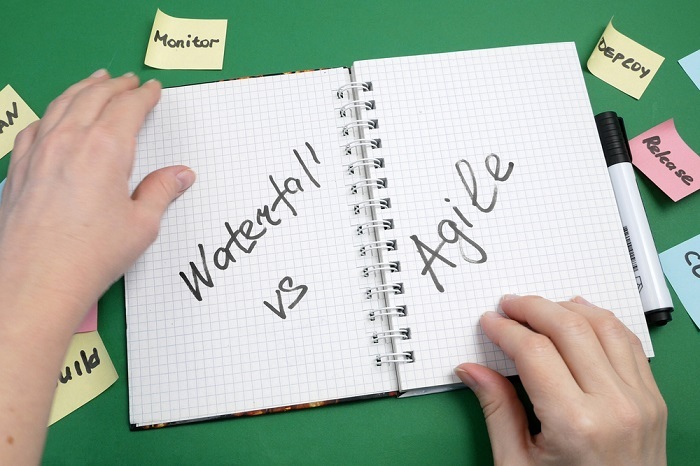
 Data Structure
Data Structure Networking
Networking RDBMS
RDBMS Operating System
Operating System Java
Java MS Excel
MS Excel iOS
iOS HTML
HTML CSS
CSS Android
Android Python
Python C Programming
C Programming C++
C++ C#
C# MongoDB
MongoDB MySQL
MySQL Javascript
Javascript PHP
PHP
- Selected Reading
- UPSC IAS Exams Notes
- Developer's Best Practices
- Questions and Answers
- Effective Resume Writing
- HR Interview Questions
- Computer Glossary
- Who is Who
What is Waterfall and How Does It Compare to Other Methodologies?
The Waterfall methodology has been a common approach to project management for many years, having roots in the manufacturing industry extending back to the 1950s.

It has now been used by a wide range of industries, including software development, construction, and manufacturing. This article examines the Waterfall methodology's core ideas and phases, as well as its advantages and disadvantages in comparison to other prominent approaches such as Agile, Scrum, and Kanban.
It also gives real-world examples of firms that have implemented Waterfall successfully and analyses why it worked for them.
The History and Origins of the Waterfall Methodology
The Waterfall methodology has been used for many years to manage projects. It is thought to have originated in the 1950s in the manufacturing industry and was later adopted by the software development industry in the 1970s.
The Waterfall methodology is named after a sequential, step-by-step process in which each phase flows down into the next. The requirements-gathering phase is followed by design, implementation, testing, and maintenance.
The key Principles and Phases of the Waterfall Methodology
The Waterfall methodology entails breaking down a project into phases, each with its own set of deliverables and milestones.
The Waterfall methodology's key principles include a focus on detailed planning and documentation, a clear definition of project scope and requirements, and a rigidly structured process for transitioning from one phase to the next.
This methodology consists of five stages: requirements gathering and analysis, design, implementation, testing, and maintenance. Each phase must be completed before proceeding to the next, and changes made in one phase can be difficult and costly to implement in subsequent phases.
Pros and Cons of Using the Waterfall Methodology

Waterfall, like any other methodology, has pros and cons.
Pros
Clear structure ? The Waterfall methodology has a well-defined structure that makes it simple to understand and apply. Each phase of the project is completed before moving on to the next, making tracking progress simple.
Reduced risk ? Because each phase is completed before moving on to the next, errors and defects are less likely to be carried forward into the next phase.
Cons
Limited flexibility ? Waterfall methodology is rigid, which means that any changes to the project must go through a formal change request process. This can take time and may cause delays.
No customer involvement until the end ? Because the Waterfall methodology is designed to complete the project before involving the customer, there may be few opportunities for feedback until the project is completed.
Comparing Waterfall to other Popular Methodologies like Agile, Scrum, and Kanban
In Waterfall methodology, the entire project is completed in phases. Each phase must be completed before moving on to the next. It's a tried-and-true method that works well when the requirements are well-defined and unlikely to change.
Agile, on the other hand, is a more adaptable methodology that prioritizes customer satisfaction and adjusts to changing requirements throughout the project. It's more collaborative and involves continuous delivery of small parts of the project.
Scrum is an Agile methodology that emphasizes collaboration, communication, and speed. It divides the project into shorter phases called sprints, during which the team works to complete a certain amount of work.
Kanban is another Agile methodology that focuses on visualizing and limiting the amount of work in progress at any given time. It's an excellent choice for teams that need to be able to respond to changing priorities while maintaining a consistent workflow.
Real-world Examples of Companies that have Successfully used Waterfall, and why it Worked for them
Many companies have used the Waterfall project management methodology with success. The construction of the Hoover Dam in the United States, which used the Waterfall approach, is one real-world example. The project was finished on time and within budget, and it was deemed a huge success.
Waterfall worked well for the construction of the Hoover Dam because it was a large-scale project with well-defined scope and requirements. Furthermore, the Waterfall methodology enabled a step approach to the project, with each phase completed before moving on to the next.
This contributed to the completion of each stage of the project thoroughly and without errors, which is critical in a project as large and complex as the Hoover Dam.
The role of Waterfall in Industries like Software Development, Construction, and Manufacturing
In software development, the Waterfall methodology follows a linear process that begins with requirements gathering, then moves on to design, coding, testing, and finally deployment. This approach has the advantage of providing a clear plan of action, and each stage can be reviewed and approved before moving on to the next.
Agile methodologies place a premium on responding to change and collaborating with stakeholders to quickly produce a minimum viable product with the flexibility to make changes as needed.
Common Misconceptions About Waterfall and how to Overcome Them
Many people believe Waterfall is archaic and ineffective. However, according to a 2021 survey, 43% of organizations still use the Waterfall methodology for their projects.
Waterfall methodology is frequently misunderstood as being too rigid and inflexible. Some people think that once a phase of the project is completed, it cannot be revisited. This, however, is not the case. Each phase in Waterfall builds on the previous one, and changes can be made during each phase if necessary.
To overcome these misconceptions, it is critical to understand the Waterfall methodology's strengths and weaknesses and to apply it in situations where it is most appropriate. It is also critical to communicate clearly with stakeholders about the project timeline and potential risks, as well as to develop a solid project management plan to keep the project on track.
Tips for Implementing Waterfall Effectively in your team or Organisation
Here are some pointers to help you successfully implement Waterfall in your team or organization ?
Define the project scope and requirements clearly ? A clear understanding of the project's scope and requirements is critical to Waterfall's success. According to a Project Management Institute study, the leading cause of project failure is incomplete or poorly defined requirements.
Create a detailed project plan ? Waterfall requires a detailed project plan that outlines each task and its dependencies. This enables you to detect potential bottlenecks and address them before they become issues. According to a Standish Group survey, projects with detailed project plans were 20% more likely to succeed than those without.
Monitor progress and adjust as necessary ? Keep an eye on the project's progress and make adjustments as needed. This allows you to identify potential issues early on and address them before they become larger problems. According to a McKinsey study, projects that were monitored and adjusted as needed were 1.5 times more likely to succeed than those that were not.
Case Studies of Waterfall Projects that Failed, and What we can Learn From Them
Let's look at some failed waterfall project case studies and what we can learn from them ?
The Sydney Opera House ? The Sydney Opera House's construction was a waterfall project that encountered several issues, including cost overruns, design changes, and delays. These issues arose as a result of the project team's inability to accurately estimate the resources required and a lack of communication among team members.
The Denver Airport ? The Denver Airport was yet another waterfall project that failed. It had significant problems, such as cost overruns, delays, and a broken baggage handling system. The lack of proper testing and quality assurance procedures was the root of these issues.
The FBI's Virtual Case File Project ? The Virtual Case File Project of the FBI was a waterfall project that aimed to create a new case management system. However, the project was plagued by significant delays and cost overruns and was eventually abandoned. The failure was caused by a lack of end-user involvement in the project design and development process.

